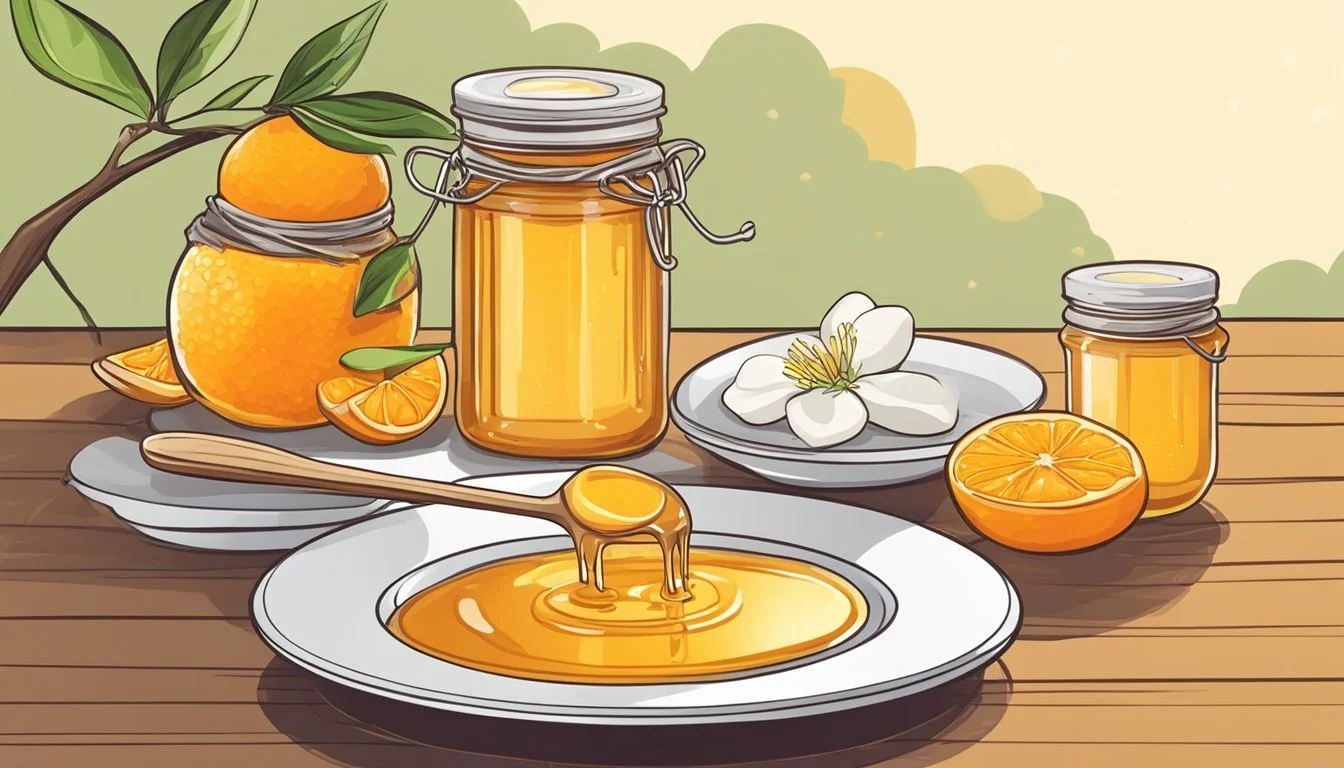How to Substitute Orange Blossom Honey for Regular Honey
A Simple Swap Guide
Orange blossom honey (What wine goes well with honey?) is a unique variety of honey known for its light, citrus-scented sweetness derived primarily from the nectar of orange tree blossoms. Unlike regular honey, which can come from the nectar of various flowers, orange blossom honey has a distinct flavor profile with hints of orange that add a special touch to recipes. When substituting orange blossom honey for regular honey, the subtle citrus notes can enhance dishes and may lead to a change in the overall flavor dynamic of the recipe.
Understanding Orange Blossom Honey
Orange blossom honey, renowned for its unique qualities, is a distinct variety of honey produced primarily from the nectar of orange tree flowers.
Origins and Characteristics
Orange trees, the source of nectar for orange blossom honey, are prolifically cultivated around the world. Bees collect this nectar and create a honey that is not only distinct in flavor but also in its aroma and color. Raw orange blossom honey is often a light, golden hue with a fresh, citrus scent.
Health Benefits
A natural antiseptic, orange blossom honey is rich in antioxidants and has been used to aid in healing topical wounds like burns, scrapes, and ulcers. It contains propolis and bee pollen, enhancing its health benefits compared to regular honey.
Flavor Profile
The flavor of orange blossom honey is subtle with a hint of citrus, differentiating it from the more neutral palettes of regular honey. Its floral undertones and sweetness make it an excellent choice for both culinary uses and as a natural sweetener in various beverages.
Comparing Honey Varieties
When substituting orange blossom honey for regular honey, one must consider the unique characteristics of different honey varieties including their flavors, colors, and nutritional content.
Different Types of Honey
Various types of honey exist, each with distinct sources and properties. Clover honey, commonly seen on grocery shelves, is light and mildly sweet. Manuka honey comes from New Zealand and Australia and is renowned for its stronger flavor and health qualities. Buckwheat honey is darker, with a stronger, molasses-like flavor. Orange blossom honey, the focus of substitution, typically evokes a citrus scent and flavor due to bees pollinating citrus plant blossoms.
Flavor and Color Differences
The flavor and color of honey are influenced by the floral sources the bees visit. Light-colored honeys, such as clover and orange blossom, are generally milder and fruity. Contrastingly, dark honeys like buckwheat are robust and earthy. The sensory qualities of orange blossom honey—a light, golden hue with citrus notes—may vary when replaced with another type of honey, altering the intended flavor profile of a dish.
Lighter Honeys:
Color: Pale yellow to light amber.
Flavor: Mild, floral, and sweet.
Darker Honeys:
Color: Dark amber to nearly black.
Flavor: Strong, rich, and often malty.
Nutritional Content Comparison
Honey's nutritional content changes slightly with variety. Raw honey retains more enzymes, antioxidants, and nutrients because it's less processed than regular honey. Minerals like calcium, zinc, and potassium can vary among types, with dark honeys, including buckwheat, generally richer in these minerals. Fructose and glucose levels, contributing to honey's sweetness, also differ, yet not significantly enough to affect dietary considerations when substituting.
Honey Type Antioxidants Enzymes Minerals Raw Honey High High Varied Clover Moderate Moderate Low Manuka Very High High High Buckwheat Very High Moderate High
In summary, when substituting orange blossom honey with another type, these comparisons provide a foundation to understand the expected differences in taste, appearance, and nutritional benefits.
Culinary Applications
When substituting orange blossom honey for regular honey, one must consider its distinctive floral taste and the effect this has on the sweetness and flavor profile of the dish.
Baking with Honey
In baking, the unique citrus notes of orange blossom honey can add a subtle depth to recipes. Because orange blossom honey is slightly sweeter than regular honey, bakers should adjust the quantity to achieve the desired sweetness.
Muffins and Cakes: Use 3/4 cup of orange blossom honey for each cup of regular honey.
Adjusting for Acidity: If the recipe does not contain baking soda, add 1/4 teaspoon to neutralize the acidity.
Honey in Beverages
Orange blossom honey's floral tones are well-suited for sweetening beverages.
Tea: Stir a spoonful into a cup of hot tea to enhance its flavor without overpowering.
Cocktails: Mixologists can use it as a sweetener in drinks for a complex taste.
Cooking and Marinades
The honey's fragrant qualities make it a versatile ingredient in cooking and creating marinades.
Marinades: Combine with soy sauce and garlic for a flavorful poultry or tofu marinade.
Sauces and Drizzles: It can serve as a base for sweet and savory sauces or as a drizzle over yogurt, oats, or granola.
Cooking: When glazed over vegetables or used in stir-fries, it imparts a mild sweetness that complements a variety of dishes.
Substitution Guidelines
When substituting Orange Blossom Honey with regular honey, understanding the balance of sweetness and aroma is key. The distinct citrus and floral notes of Orange Blossom Honey must be taken into account to ensure the substituted honey complements the overall flavor of the dish.
Adjusting for Sweetness
Regular honey can be sweeter than Orange Blossom Honey. Users might consider reducing the amount slightly if the recipe is sensitive to changes in sweetness levels.
To maintain the sweetness balance, a direct 1:1 substitution ratio can be used as a starting point, adjusting to taste.
Considering Aroma and Taste
Orange Blossom Honey is known for its light amber color and citrus-flavored notes. Regular honey often lacks these fruity undertones.
One can introduce a hint of citrus zest to replicate the flavor profile, using a small amount of lemon or orange zest mixed with the honey.
Proportion and Measurement
For the accurate conversion of Orange Blossom Honey to regular honey, use standardized measurements, such as tablespoons or cups.
A table for quick reference:
Orange Blossom Honey Regular Honey Citrus Zest (optional) 1 tablespoon 1 tablespoon 1/4 teaspoon 1 cup 1 cup 1 teaspoon
The syrup-like consistency of honey should be consistent, so no adjustments in the recipe's moisture content are generally needed.
Health Considerations
When substituting orange blossom honey for regular honey, one must take into account not just the taste, but also health considerations. These include potential allergies, the honey's unique benefits for throat and skin, and its antimicrobial properties.
Allergies and Sensitivities
Orange blossom honey, like regular honey, can trigger allergies for individuals sensitive to pollen. The honey contains trace amounts of pollen from orange blossoms, which could lead to allergic reactions. Those with a citrus allergy should particularly exercise caution.
Benefits for Throat and Skin
Orange blossom honey has been acknowledged for its soothing effects on the throat, helping to calm irritation and ease sore throat symptoms. It coats the throat lining, which may benefit individuals suffering from colds or bacterial throat infections. Additionally, its anti-inflammatory properties can be beneficial for the skin, aiding in reducing inflammation when applied topically.
Antimicrobial and Healing Properties
The honey possesses antimicrobial qualities, largely due to an enzyme that produces hydrogen peroxide, a known antiseptic. Its content of phenolic acids also contributes to the antibacterial effect, which can help protect against infections. These properties make orange blossom honey advantageous for wound healing, as it could inhibit the growth of harmful bacteria and support the immune system in the healing process.
Practical Tips and Tricks
When substituting orange blossom honey for regular honey, preserving the quality and purity is essential. Proper storage, preventing crystallization, and revitalizing solidified honey are key to maintaining its distinctive floral notes and organic properties.
Storing Honey
Storage is crucial for maintaining the purity and quality of honey. Orange blossom honey should be stored in a cool, dry place away from direct sunlight. Glass jars with airtight lids are ideal for preserving flavor and preventing contamination. Organic honey should not be stored in plastic as it can affect its taste and purity.
Do: Use glass containers with tight lids.
Don't: Expose honey to direct heat or sunlight.
Preventing Crystallization
Crystallization is a natural process, particularly in pure, unprocessed honey. To prevent it, one can maintain a consistent storage temperature. If the honey is pasteurized, this process may occur more slowly due to the lower pollen content.
Temperature: Keep honey at room temperature (between 70°F and 80°F).
Consistency: Avoid temperature fluctuations.
Revitalizing Solidified Honey
If honey crystallizes, one can return it to a liquid state by gently heating it. The water content in honey should not exceed 18% to prevent fermentation. Slowly warm the honey jar in a water bath, ensuring the temperature does not exceed 95°F to preserve its natural enzymes and qualities.
Water Bath: Place the honey jar in warm water.
Heat: Do not heat above 95°F to maintain honey’s beneficial properties.
Regional Variations
The variety of orange blossom honey depends significantly on the geographical location of the orange groves from which the nectar was collected. Both American and global varieties present distinct flavor profiles influenced by the regional citrus flowers available for bees to pollinate.
American Honey
Florida:
Florida is renowned for its orange groves, resulting in honey with a pronounced sweet citrus essence. It is predominantly from orange trees, distinguishing it from more generalized citrus honeys.
California:
Not far behind is California, with its vast citrus expanse producing a lighter honey that carries a subtle sweetness and a hint of fruity undertones reflective of the variety of citrus trees in the state.
Texas:
Texas also contributes to the market, delivering honey that shares the bright qualities of the orange blossoms prevalent in its groves.
Global Varieties
Spain and Mexico:
Originating from these countries, orange blossom honey is cherished for its light and delicate nature. The presence of diverse citrus trees in these regions shapes its unique character.
Italy and France:
In Italy and France, orange blossom honey incorporates the refined floral notes tied to the local grove flowers, which bees pollinate, contributing to the diversity found in the market.
Israel:
Middle Eastern varieties, particularly from Israel, are noted for their aromatic nuances that reflect the region's particular climate and citrus flora.
By understanding these regional variations, one can select an appropriate substitute for orange blossom honey that will best mimic the intended flavor profile within recipes or uses.
Environmental Impact
Substituting orange blossom honey for regular honey can have notable environmental implications, especially in terms of the sustainability of honey production and beekeeping practices.
Sustainability of Honey Production
The sustainability of honey production is paramount in mitigating environmental impact. Sustainably managed hives produce honey with a lower ecological footprint. Beekeepers play a crucial role in this, as they must ensure that their honey extraction methods do not overharvest, leaving enough honey for the bees’ sustenance.
Pollination Contribution: Honey production is intertwined with bees' role in pollination, which is crucial for the environment. By pollinating a variety of plants, bees support the health of ecosystems.
Sustainable Practices: Sustainable beekeeping involves maintaining hives in a way that prevents overuse of any single area’s floral resources. This includes rotational grazing or ensuring hives are not densely populated in one area to prevent pollen depletion.
Beekeeping Practices
The practices of beekeepers can have a direct correlation with environmental health. Responsible beekeeping ensures that bees are kept in conditions that mimic their natural habitats which can lead to healthier bee populations.
Hive Management: Careful management of hives helps maintain bee health and reduces the chance of colony collapse.
Environmental Stewardship: Conscious beekeepers often engage in environmental stewardship by protecting the areas around their hives, reducing the use of chemicals, and encouraging plant diversity to ensure a rich source of pollen.
In summary, the production of orange blossom honey, like all honey, should be conducted in a way that prioritizes the health of bee populations and the ecosystems they support.









